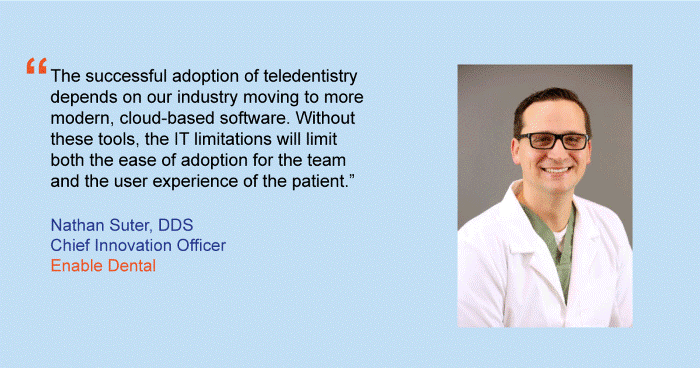Enter your email to receive the CareQuest newsletter:
May 27, 2022
As we continue to recover from the COVID-19 pandemic, the benefits of telehealth to connect patients with health care providers have become clear. Whether it’s telemedicine, teletherapy, or teledermatology, telehealth is here to stay. And that includes teledentistry, which can increase access to oral health care and decrease costs — now and beyond the pandemic.
In a recent CareQuest Institute webinar, Marybeth Shaffer, DMD, dental director of Community Action Agency of Columbiana County in Ohio, and Nathan Suter, DDS, chief innovation officer at Enable Dental, discussed how teledentistry has improved their care delivery in public and private practices and how they’ll continue to use the valuable technology in their practices. Caroline McLeod, RDH, MS, value-based solutions manager at CareQuest Institute, kicked off the webinar by sharing some of the latest research on provider perceptions on the value of teledentistry.
“Teledentistry is a tool that providers and programs can leverage to improve the care that they’re already offering and to extend that care as well,” said McLeod. “It’s valuable to providers as well as patients.”
Reaching New Populations in Ohio with Teledentistry
At the Community Action Agency of Columbiana County, Shaffer and her team use teledentistry to accomplish three main objectives: to triage emergency patients, to facilitate referrals, and to facilitate remote periodic examinations. Using teledentistry technology to triage emergency patients saves states money, providing an alternative to costly care in emergency departments. Using it for referrals also helps support care coordination and interoperability between providers at community health centers.
 In all of these cases, teledentistry serves as an important method of eliminating barriers to care — especially for rural patients who may not have a dental provider nearby and for student-based oral health care programs that allow children without a dental home to receive the care they need.
In all of these cases, teledentistry serves as an important method of eliminating barriers to care — especially for rural patients who may not have a dental provider nearby and for student-based oral health care programs that allow children without a dental home to receive the care they need.
“What was our value proposition?” said Shaffer when discussing teledentistry as a tool for school-based care. “We felt if we brought preventive care to children rather than waiting for parents to bring children to care, we might have some impact. We also have a problem with health literacy in our rural Appalachian county, and we were hoping to improve the health care knowledge of our county. Now, all patients that we see have a dental home — and many times they have siblings that we are trying to encourage to come in, as well as the parents.”
Expanding Business — and Access to Care
“If you want to know whether the business case [for teledentistry] makes sense, you can see that there is a cost-benefit that makes sense to do this,” said Suter, as he explained the value to private practices. According to a recent CareQuest Institute study, teledentistry visits were on average less expensive ($99 per visit) than in-person visits ($114 per visit), making care more accessible to a wider range of people.
And based on his own experiences, Suter agrees that using teledentistry increases access and availability of care.
“Before the pandemic, we would use teledentistry to supplement the schedule if I wasn’t in the office,” he said. “After lockdown, we started using teledentistry to catch up on hygiene-only days and would use it as a tool to expand access to care.”
Using teledentistry technology, Suter and his team have continued to refine their workflow. They’re able to do radiographs, extra-oral photos, intra-oral photos, tooth charting, and take logic-based clinical notes — all through their teledentistry software. It allows them to work better as a team and to increase capacity without adding operational costs to the practice.
“The successful adoption of teledentistry depends on our industry moving to more modern, cloud-based software,” Suter said. “Without these tools, the IT limitations will limit both the ease of adoption for the team and the user experience for the patient.”
Teledentistry is becoming a permanent feature in our oral health care system, with both patients and providers recognizing the benefits of teledentistry appointments. In fact, almost 85% of oral health professionals said dentistry was ready to accept teledentistry as a care delivery method and, in a 2020 study, 86% of patients said they would recommend teledentistry to another person.
As we move past the difficulties of a COVID world, telehealth — and teledentistry specifically — will continue to be an important care delivery tool that provides a flexible, convenient way to connect patients and providers in different physical locations.
Editor’s Note: View the recording and slides from “Building a Teledentistry Program That Expands Access and Increases Equity” and explore upcoming CareQuest Institute webinars.